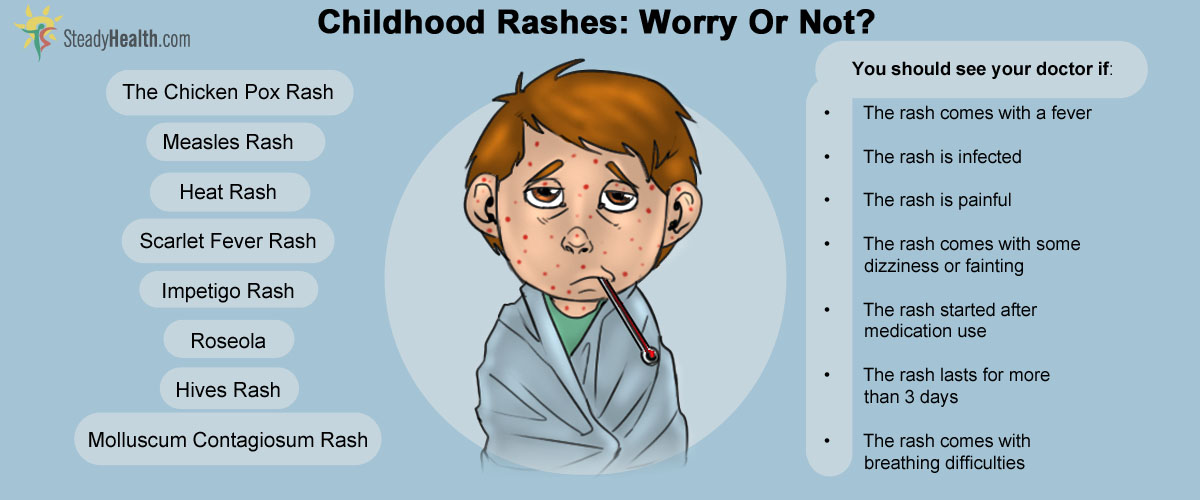Table of Contents
From a general point of view, childhood rashes are actually a very common phenomenon, and like many other symptoms, a rash tends to resolve once the cause of it is properly identified. When it comes down to it, rashes are just the skin’s way of letting you know that something is irritating it. Although the majority of rashes are pretty harmless, some of them could be quite worrisome and even dangerous, and identifying the clue regarding which we should worry about or not is key in dealing with those skin affections.
So, does that rash on your kid's skin make you worry? That's fair, but It could simply be an innocent rash. But in order to recognize if it poses a danger to your child or not, let us identify the most common types of rashes that develop in childhood and how to deal with them. Armed with the right knowledge, you won't have to worry anymore, and you can make sure your child is safe. Let's take a look.
Here is a list of all the most common skin rashes that occur during childhood and how you can identify and treat them:
The Chicken Pox Rash
Chicken pox is a very contagious disease caused by primary infection with a virus from the herpes family, called the Varicella Zoster Virus (VSV). The chicken pox rash is characterized by fluid filled vesicles all over the body. It begins as red marks that resemble mosquito bites. Within a few hours, the marks develop into blisters that would end up bursting out, potentially leaving some scabs on the skin.
Alongside with the rash, your child might also present with flu-like symptoms (a low grade fever, a headache or a sore throat). Like previously mentioned, this rash is highly contagious, and remains so until all the blisters have dried and crusted. This generally takes up to 6 days, within which the child should be isolated to avoid him transmitting the disease to others. So yes, the chicken pox rash is something we should worry about. The chicken pox blisters can also get infected if the child scratches the skin (it is very itchy), which would cause lesions.
One dose of vaccine is given during childhood. However, because the immunity is not long-lasting, a booster is generally required 5 years after the previous dose.
Measles Rash
Also called rubella, measles is another highly contagious disease caused by a virus, the Measles Virus (which belongs to the family of Paramyxoviridae). The virus is transmitted via respirator droplets and nasal secretions, from one child to another through hand shaking or other forms of close contact.
The measles rash starts few days after an episode of fever and appears as a generalized rash all over the body.
It is reddish to brownish in appearance, and is described as “maculopapular”.
Another key characteristic marker of measles is the presence of Koplik’s spots, which are small areas of red-blue white spot in the oral mucosa. The rash of Rubella (German Measles) commences as macules and papules all over the forehead; that diffusely spread to the face, the trunk and the extremities.
Read More: Once An Almost-Forgotten Disease, Measles Outbreak Strikes Children And Adults
Heat rash
Another name for the “oh-so common” heat rash is Miliaria. Heat rash is one of those we should not worry about, as it tend to disappear with decreased exposure to heat and sun. Heat rash presents as tiny raised red bumps on the surface of the skin, on heat exposed areas (face, neck, arms, legs, etc.) For some people it is itchy, while for others it is not.
- Mindmap by steadyhealth.com
- Photo courtesy of Jim Champion by Flickr : www.flickr.com/photos/treehouse1977/3316752569/
- www.nhs.uk/conditions/skin-rash-children/Pages/Introduction.aspx
- www.quickanddirtytips.com/health-fitness/mens-health/when-should-you-worry-about-rash?page=all
- www.parents.com/baby/health/rashes/rashes/
- http://kidshealth.org/parent/infections/skin/chicken_pox.html#



Your thoughts on this